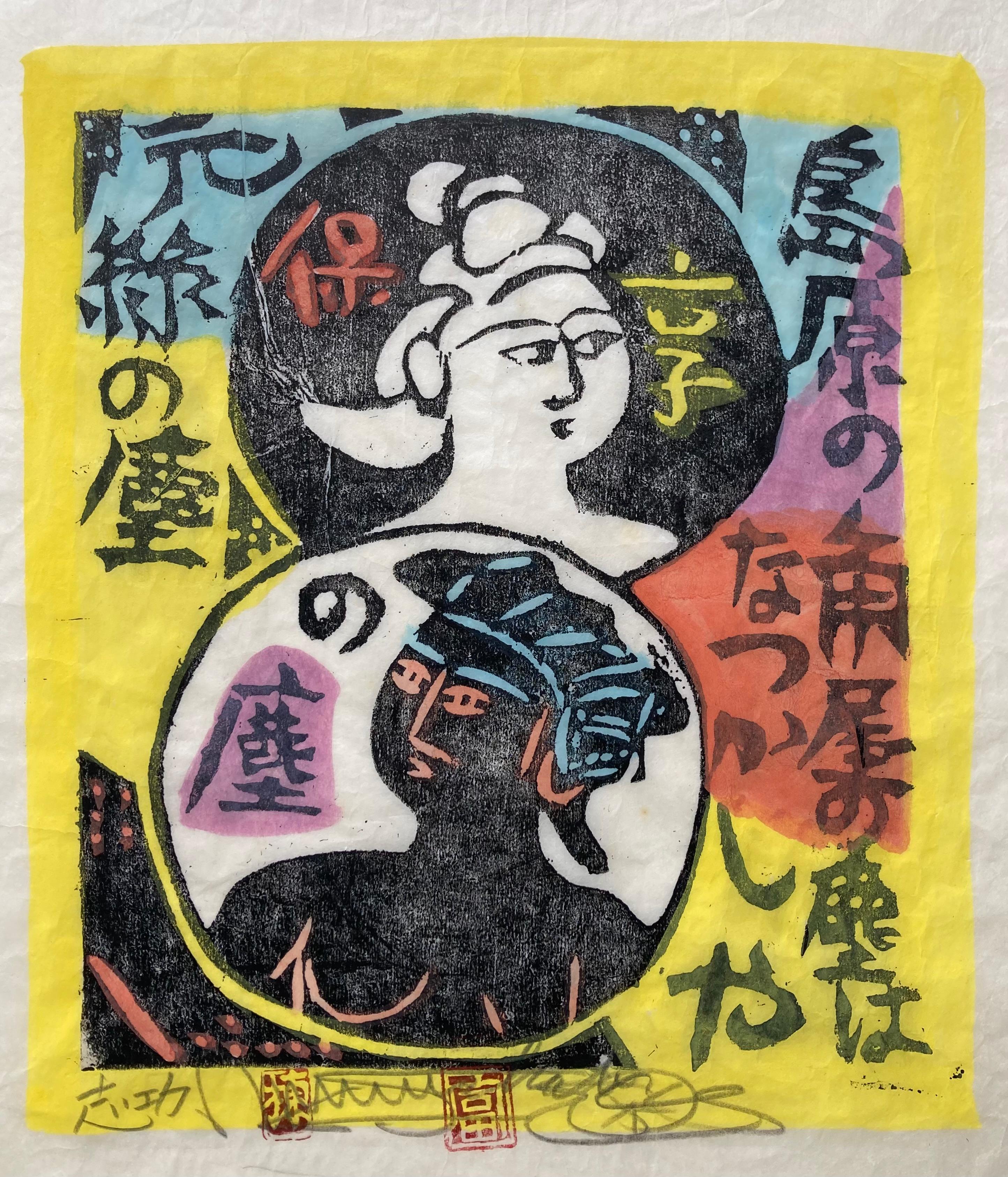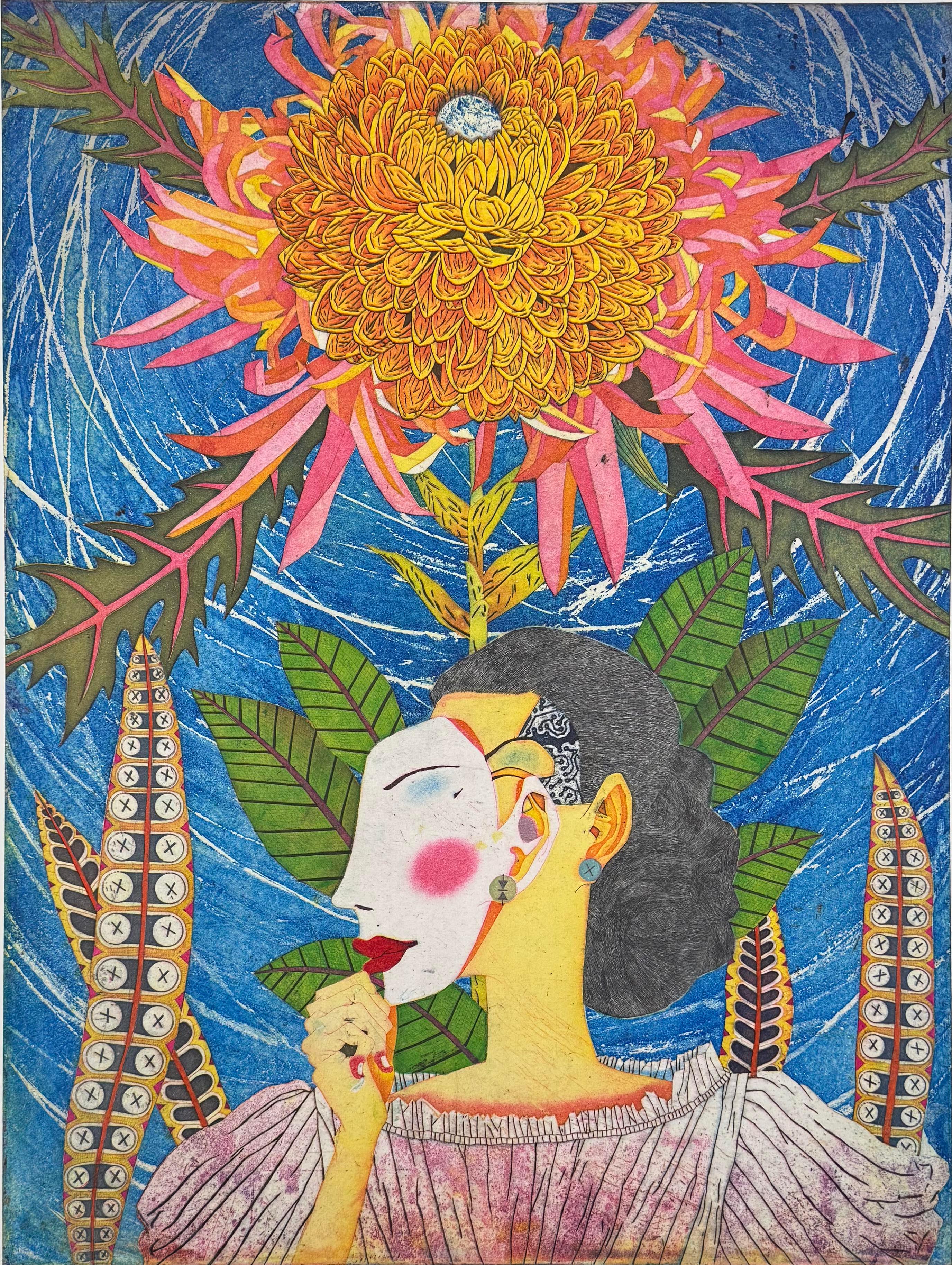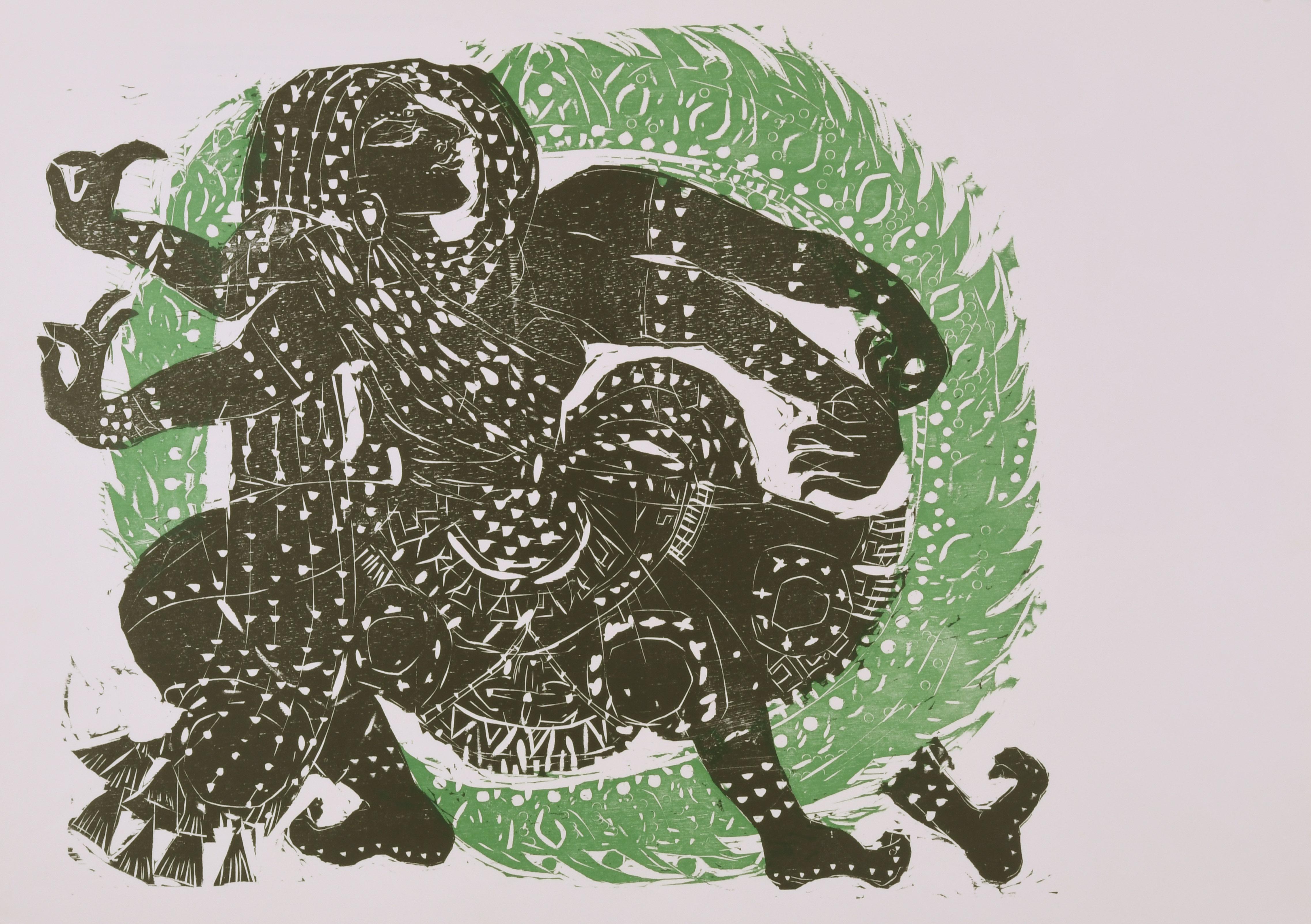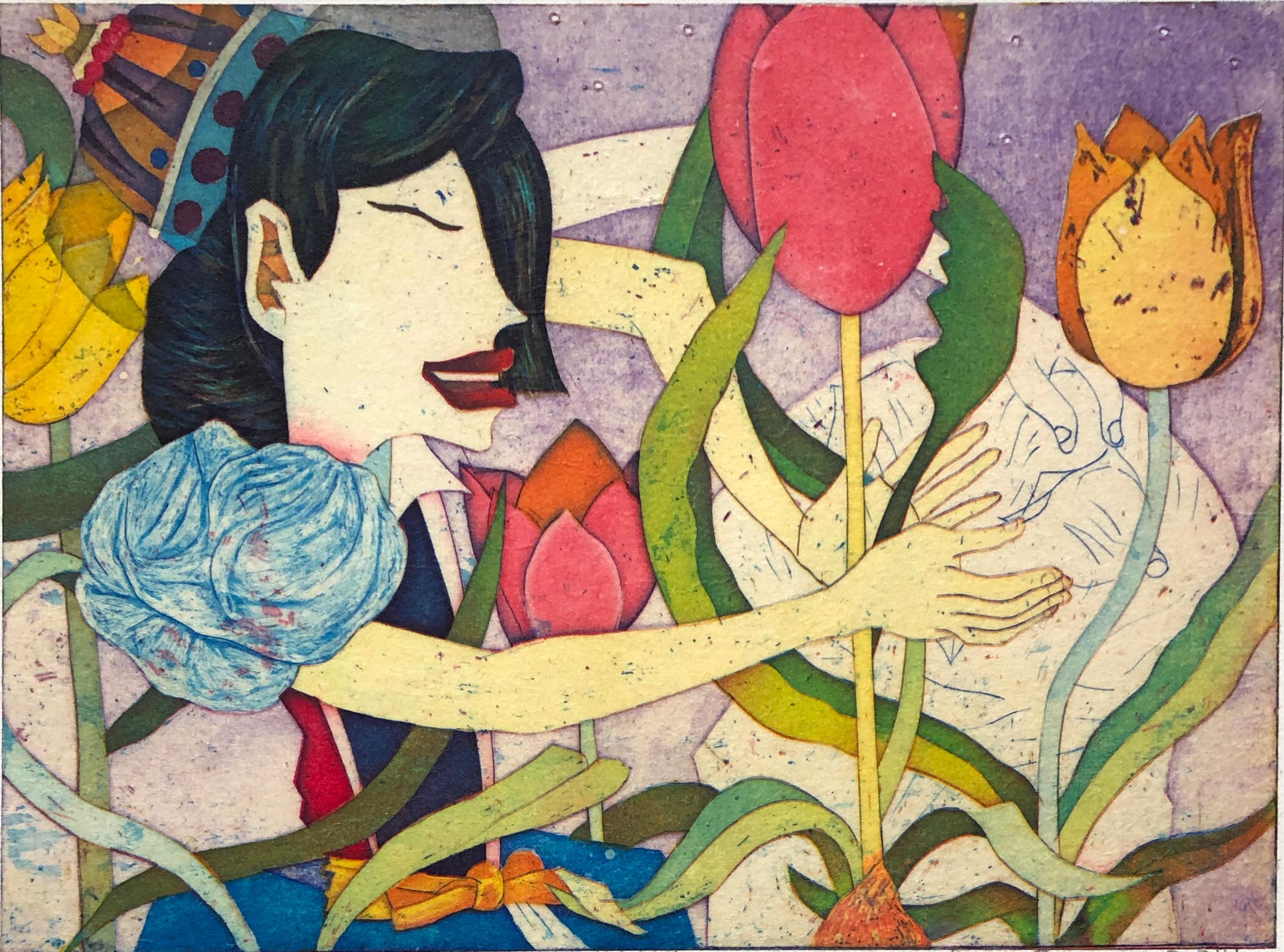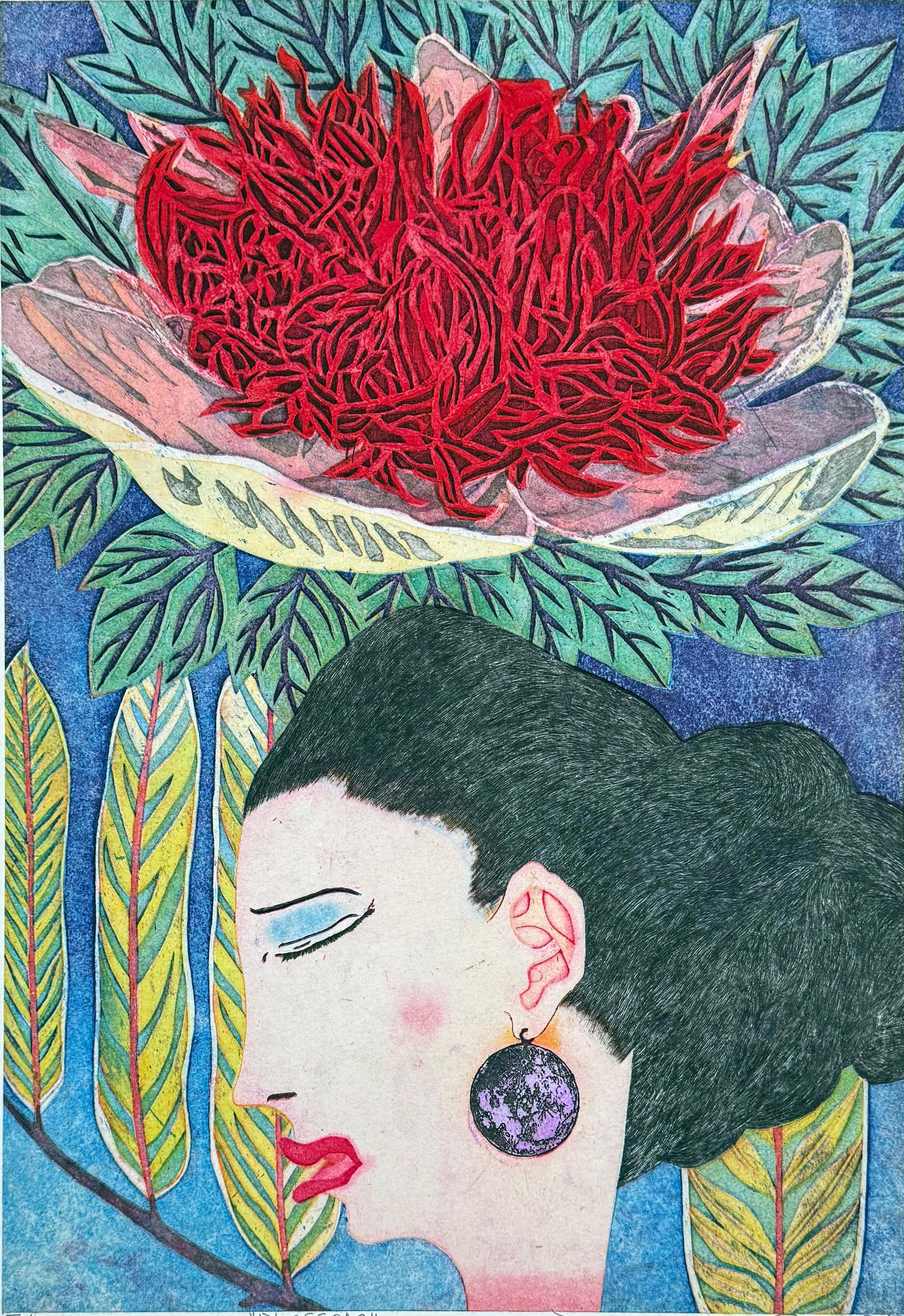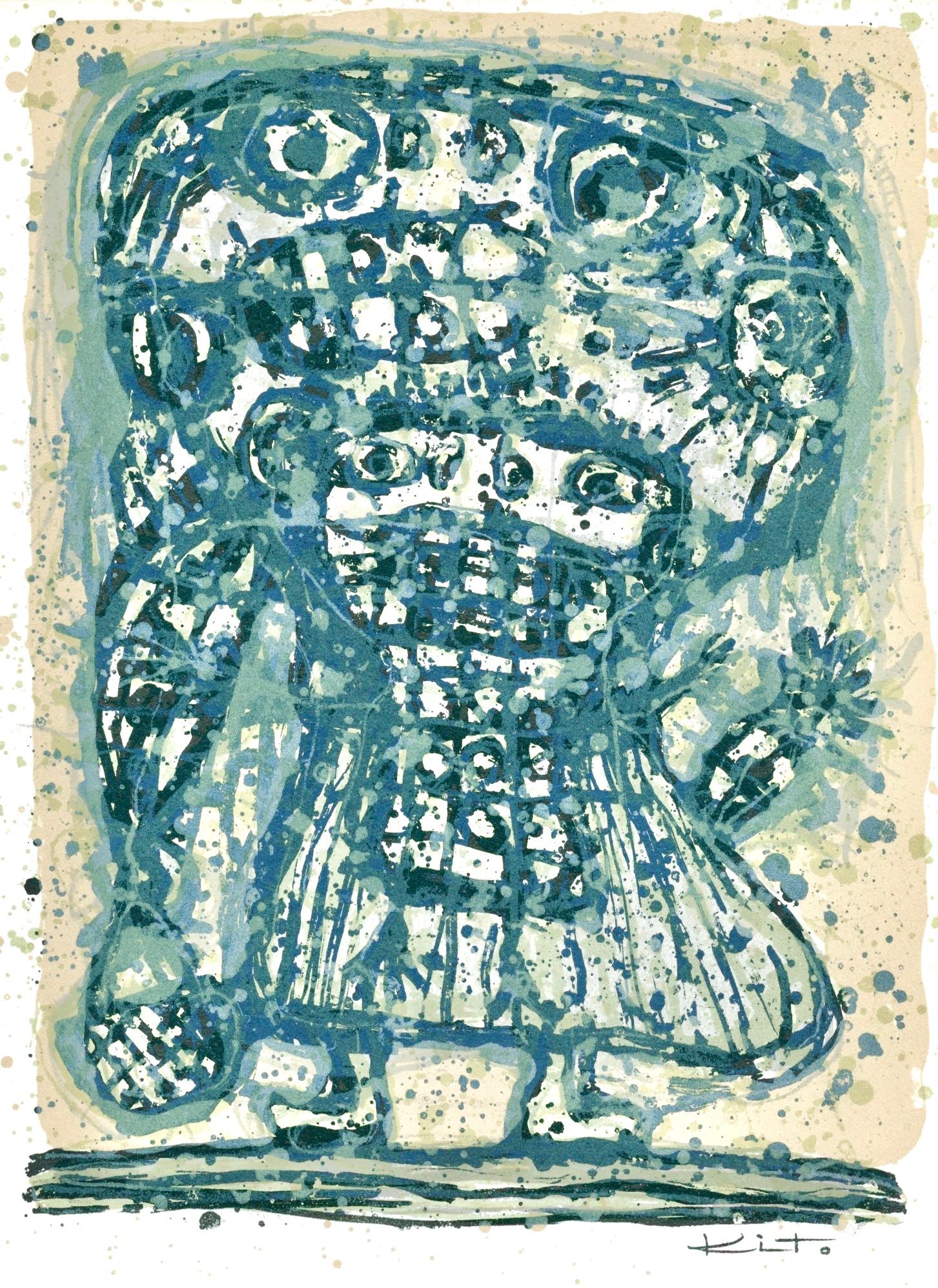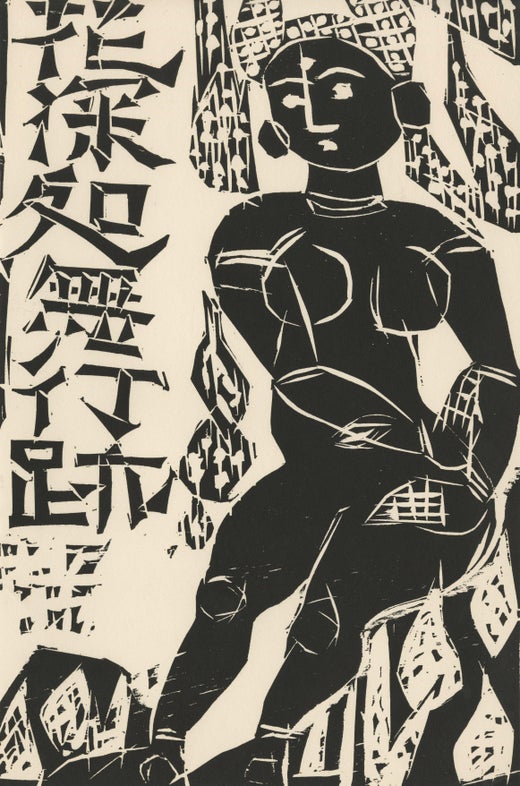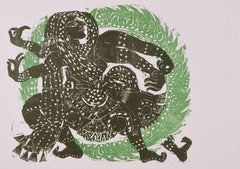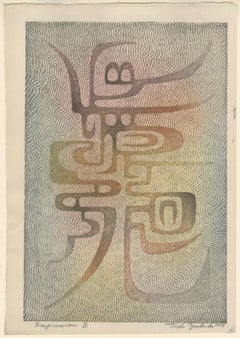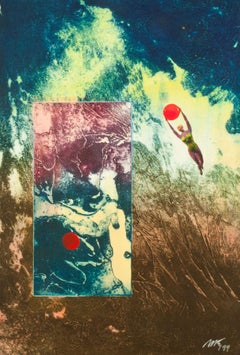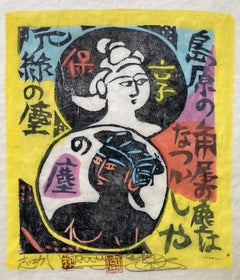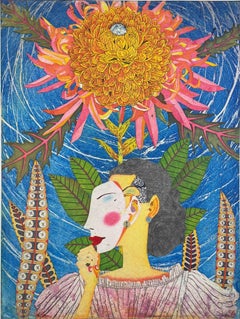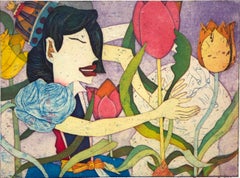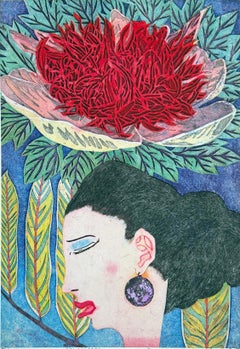Items Similar to No Footprints Show, Where the Flowers Grow Deep
Want more images or videos?
Request additional images or videos from the seller
1 of 7
Shiko MunakataNo Footprints Show, Where the Flowers Grow Deep1961
1961
$300
£231.34
€263.80
CA$427.86
A$467.60
CHF 246.07
MX$5,600.73
NOK 3,097.01
SEK 2,892.49
DKK 1,970.36
About the Item
No Footprints Show, Where the Flowers Grow Deep
Woodcut, 1961
Unsigned (as isssued)
From: The "Way" of the Woodcut, three woodcuts, 1961
Publisher: Pratt Adlib Press, Brooklyn, New York,1961
Printer: James Lanier at the Press of Igal Roodenko
Edition: 1500 books
Public Collections: MOMA
Library of Congress
Toledo Museum of Art
Condition: Excellent
Image/Sheet size: 12 x 8 1/4 inches
MUNAKATA, SHIKO (1903 - 1975 )
Born in Aomori prefecture, Shiko Munakata is a woodblock print artist best known for his black and white prints and his expressive, sketch-like lines. A self-taught artist, he began his career in oil painting, organizing the Seikokai (Blue Light Group) and exhibiting at Hakujitsukai, Bunten and Teiten. Shiko Munakata changed course in 1926 upon seeing a woodblock print by Sumio Kawakami. After brief instruction from Un’ichi Hiratsuka in 1928, Munakata became active in the woodblock printmaking community: he belonged to both Kokugakai (1932-1953) and Nihon Hanga Kyokai (1932-1938), and contributed to many Sosaku Hanga publications. Around 1936, he garnered the support of Soetsu Yamagai and other leaders of the folk art movement. Shiko Munakata’s work began to heavily feature Buddhist imagery the following year. During the bombing of Tokyo in 1945, he escaped to Toyama prefecture. Shiko Manukata continued woodblock printmaking and received first prize in international exhibitions held in Lugano (1952), Sao Paulo (1955) and Venice (1956). Visiting the United States in 1959, Munakata spent a year exhibiting his work throughout the country. Horinji Temple in Kyoto bestowed him with the honorary rank of “Hokkyo” upon his return to Japan. In 1962, he received the rank of “Hogan” from Nisseki Temple in Toyama prefecture. Shiko Munakata’s accolades continued through the end of the decade, including the Medal of Honor (1963), the Asahi Shimbun culture prize (1965), and the Order of Cultural Merit (1970).
Courtesy Ronin
Munakata 1959 Buddhis triadMunakata's prints have a distinctive spontaneity and spiritual energy. He saw himself as a temporary medium through which the design, not really his own, could be revealed. As a result, unlike Onchi Kôshirô and other artists of the sôsaku hanga (creative print: 創作版画) movement who advocated self-expression in their printmaking, Munakata disclaimed individual responsibility as an artist. For him, artistic creation was only one of many manifestations of nature's force and beauty, which is inherent in the woodblock. In Munakata's words, "The essence of hanga lies in the fact that one must give in to the ways of the board ... there is a power in the board, and one cannot force the tool against that power."
Munakata's works are in numerous private collections and in public institutions, including the Art Gallery of New South Wales; Art Institute of Chicago; Asian Art Museum, San Francisco; British Museum, London; Brooklyn Museum, New York; Carnegie Museum of Art, Pittsburgh; Cincinnati Art Museum; Detroit Institute of Art; Fine Art Museums of San Francisco; Harvard Art Museums; Honolulu Museum of Art; Japan Folk Art Museum, Tokyo; Los Angeles County Museum of Art;Metropolitan Museum of Art, New York; Minneapolis Museum of Art; Munakata Shikô Memorial Museum of Art; Museum of Fine Arts, Boston; Museum of Modern Art, New York; Museum of Modern Art, Tokyo; National Museum of Asian Art (Smithsonian), Washington, D.C.; National Museum of Modern Art, Kyoto; National Museum of Modern Art, Tokyo; Philadelphia Museum of Art; and Rijksmuseum, Amsterdam
Courtesy: Viewing Japanese Prints
- Creator:Shiko Munakata (1903 - 1975, Japanese)
- Creation Year:1961
- Dimensions:Height: 12 in (30.48 cm)Width: 8.25 in (20.96 cm)
- Medium:
- Movement & Style:
- Period:
- Condition:
- Gallery Location:Fairlawn, OH
- Reference Number:Seller: FA125221stDibs: LU14014139632
Shiko Munakata
Shiko Munakata is by many regarded as one of the most significant modern Japanese artists of the twentieth century. His art work consists of paintings, prints, ceramics and calligraphy. Looking at his art work, the way he produced it and his fame, one could be tempted to call him the Japanese Picasso of the twentieth century - in every aspect. Born in Aomori Shiko Munakata was born as the son of a blacksmith in Aomori Prefecture, located in the North of Japan's main island. He first began to paint in oil as a self-taught artist. Later in 1924 he went to Tokyo to study art. Three years after the artist's death, the city of Aomori opened the Munakata Shiko Memorial Museum of Art. The museum web site has one page with a summary of the career of the artist in English. At the age of 23 Munakata Shiko saw a woodblock print by Sumio Kawakami and decided to try woodblocks himself. Under the guidance of Unichi Hiratuka he learned the art of making moku-hanga - woodblock prints. Three years later he exhibited four woodblocks at the Shunyokai exhibition. From then on Munakata Shiko was a hanga artist - a print artist. He continued to exhibit and by and by his reputation grew. After World War II had ended, the artist became famous outside Japan. His works were shown at the Lugano Print Exhibition in 1952, the Sao Paulo Biennal in 1955, the Venice Biennal in 1956. In each of these exhibitions he was awarded with first prizes. After these successful exhibition, Munakata went to the U.S., where he lectured at different universities and had numerous solo exhibitions. Munakata Shiko preferred to call his prints banga, which could be translated like picture made from a wooden panel. Munakata was a practicing Buddhist. Many of his prints and paintings show religious subjects. Other subjects are taken from Japanese legends or from nature. Munakata's prints are larger than the traditional Japanese oban (10x15 inches = 25.4x38 cm) size. With his larger-sized prints he followed Western contemporary artist's and the buying habits of Western clients. Japanese homes are usually small and have little wall space to hang art work and therefore Japanese art buyers tend to buy smaller sizes. A Munakata print is usually in black and white. The techniques he used are woodblocks, woodcuts and lithographs. Like Pablo Picasso, Shiko Munakata worked spontaneously, fast and was extremely prolific. Shiko Munakata died in Tokyo in 1975 at the age of 72.
About the Seller
5.0
Recognized Seller
These prestigious sellers are industry leaders and represent the highest echelon for item quality and design.
Gold Seller
Premium sellers maintaining a 4.3+ rating and 24-hour response times
Established in 1978
1stDibs seller since 2013
828 sales on 1stDibs
Typical response time: <1 hour
Associations
International Fine Print Dealers Association
- ShippingRetrieving quote...Shipping from: Akron, OH
- Return Policy
More From This Seller
View AllXylon 21 Naoko Matsubara USA
Located in Fairlawn, OH
Xylon 21 Naoko Matsubara USA
Woodcuts, two which are printed in color, 1970
2 of the 5 woodcuts signed in pencil (see photos)
Five original woodcuts, two of which are signed in penci...
Category
1970s Abstract Figurative Prints
Materials
Woodcut
Impression B
By Toshi Yoshida 1
Located in Fairlawn, OH
Impression B
Color woodcut, 1959
Signed and dated lower right (see photo)
Titled lower left (see photo)
A trial proof, prior to the edition of 100, signed and numbered
Condition: Excellent
Image size: 14 1/2 x 9 3/4 inches
Provenance: Estate of the artist
by decent to his heirs
"Printmaker and painter Toshi Yoshida was born on July 25, 1911, into the respected Yoshida family of artists of Tokyo, Japan. Father Hiroshi was a celebrated landscape painter and printmaker, and mother Fujio established herself as the first female Yoshida artist as well as an Abstract artist later in her career. Younger brother Hodaka was an Abstract printmaker whose style, completely separate from his family's historic traditional bent, later influenced Toshi. Hodaka's wife Chizuko would become a pioneering female Japanese artist whose own exploration of Surrealism and Abstraction challenged the status quo. Toshi, however, as the eldest sibling, was expected to follow in his father's footsteps, and from an early age he was trained by Hiroshi in his studio.
Unable to attend formal schooling due to the polio-induced paralyzation of his leg, Toshi would instead help with his family's printmaking studio and go on sketching trips with Hiroshi. As he got older, these trips would include India and Southeast Asia, working from morning to night taking night trains to get from one destination to another. Among Toshi's favorite subjects were the animals he discovered along the way. However, these trips ended as Japan entered military dictatorship in the mid 1930s, and artists whose work showed signs of Western influence were barred from exhibiting. At this time, Toshi left Japan for China and Korea, where he would remain for the duration of the war. He stuck to patriotic themes to remain in business, and after the end of World War II, as Japan struggled to recover from wartime economic depression, he earned his living creating traditional Japanese woodcut landscapes...
Category
1950s Abstract Abstract Prints
Materials
Woodcut
Impression B
By Toshi Yoshida 1
Located in Fairlawn, OH
Impression B
Color woodcut, 1959
Signed and dated lower right (see photo)
Titled lower left (see photo)
A trial proof, prior to the edition of 100, signed and numbered
Condition: Excellent
Image size: 14 1/2 x 9 3/4 inches
Provenance: Estate of the artist
by decent to his heirs
"Printmaker and painter Toshi Yoshida was born on July 25, 1911, into the respected Yoshida family of artists of Tokyo, Japan. Father Hiroshi was a celebrated landscape painter and printmaker, and mother Fujio established herself as the first female Yoshida artist as well as an Abstract artist later in her career. Younger brother Hodaka was an Abstract printmaker whose style, completely separate from his family's historic traditional bent, later influenced Toshi. Hodaka's wife Chizuko would become a pioneering female Japanese artist whose own exploration of Surrealism and Abstraction challenged the status quo. Toshi, however, as the eldest sibling, was expected to follow in his father's footsteps, and from an early age he was trained by Hiroshi in his studio.
Unable to attend formal schooling due to the polio-induced paralyzation of his leg, Toshi would instead help with his family's printmaking studio and go on sketching trips with Hiroshi. As he got older, these trips would include India and Southeast Asia, working from morning to night taking night trains to get from one destination to another. Among Toshi's favorite subjects were the animals he discovered along the way. However, these trips ended as Japan entered military dictatorship in the mid 1930s, and artists whose work showed signs of Western influence were barred from exhibiting. At this time, Toshi left Japan for China and Korea, where he would remain for the duration of the war. He stuck to patriotic themes to remain in business, and after the end of World War II, as Japan struggled to recover from wartime economic depression, he earned his living creating traditional Japanese woodcut landscapes...
Category
1950s Abstract Abstract Prints
Materials
Woodcut
Untitled
By Mikulas Kravjansky
Located in Fairlawn, OH
Signed and dated '99 in white
Category
1990s Figurative Prints
Materials
Mixed Media
Kimono Fabric Design
Located in Fairlawn, OH
Kimono Fabric Design
Color woodcut with pochoir embellishments on fine silver mica ground. 1936
Unsigned as usual
From "Ukiyoe Kosode," a deluxe limited edition album of kimono fabri...
Category
1930s Showa Abstract Prints
Materials
Screen
Awakening
By Kazuhisa Honda
Located in Fairlawn, OH
Each print signed and numbered in pencil by the artist
Total edition: 92: 75 with Arabic numerals; 10 Artist's proofs with Roman numerals; 7 Hors Commerce with Roman numerals
Image...
Category
1980s Contemporary Landscape Prints
Materials
Mezzotint
You May Also Like
Untiled Faces
By Shiko Munakata
Located in Santa Monica, CA
SHIKO MUNAKATA (1903 – 1975)
UNTITLED FACES ca 1960. -- Color woodcut on thin Japan paper. Signed in pencil. with Chops, printed image 15 x 12 ¾”, Sheet 19 7/8 x 15 7/8” $1,...
Category
1960s Modern Figurative Prints
Materials
Woodcut, Color
CN 31773
By Yuji Hiratsuka
Located in Palm Springs, CA
"CN 31773" merges botanical motifs with the human form, reflecting the artist’s ongoing exploration of the interconnectedness between people and their environments. The title refers ...
Category
2010s Contemporary Figurative Prints
Materials
Intaglio
Nature, Nurture
By Yuji Hiratsuka
Located in Palm Springs, CA
While the images have some resemblance to traditional Japanese Ukiyo-e prints, their sense of whimsy, satire and irony relate more closely to contemporary life and western sensibilit...
Category
2010s Contemporary Figurative Prints
Materials
Intaglio
Blossom
By Yuji Hiratsuka
Located in Palm Springs, CA
Signed, title and numbered in pencil by the artist.
While the images have some resemblance to traditional Japanese Ukiyo-e prints, their sense of whimsy, satire and irony relate mor...
Category
2010s Contemporary Figurative Prints
Materials
Intaglio
Akira Kito, Child, from Prints from the Mourlot Press, 1964
Located in Southampton, NY
This exquisite lithograph by Akira Kito (1909–1995), titled Enfant (Child), from the album Prints from the Mourlot Press, exhibition sponsored by the French Embassy, circulated by th...
Category
1960s Modern Abstract Prints
Materials
Lithograph
$716 Sale Price
20% Off
Free Shipping
Mizuhiki
By Katsunori Hamanishi
Located in New Orleans, LA
"Mizuhiki" is an exclusive publication by Stone + Press in an edition of 100.
Katsunori Hamanishi was born in 1949 on Hokkaido island - Japan's second largest island. In 1973 he fi...
Category
1990s Contemporary Abstract Prints
Materials
Mezzotint
$82 Sale Price
25% Off
More Ways To Browse
Dali Japanese
Dali Paradise Canto
David Hockney Olympics
Decameron Dali
Die Schaffenden
Diego Rivera Print New York Graphic Society
Foujita Woodcut
Francois Langlois
G Barbier
George Bellows Lithographs
George Harrison Marks
George Rouault Woodcut
Gerard Dou
Giacometti Annette
Giorgio Morandi Etching
Goupil Prints
Henry Moore Sculptural Ideas
Hermes Paris Rue Du Faubourg Saint Honore
